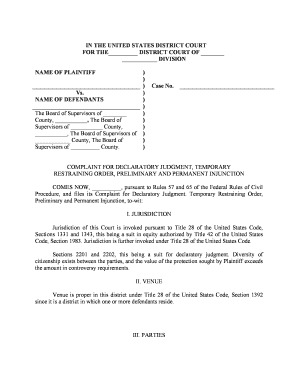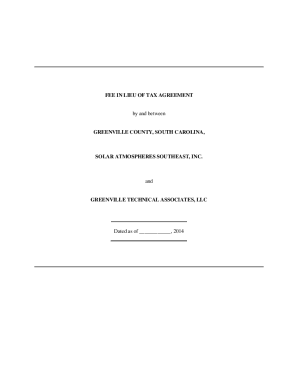
Get the free medical records form
Show details
CERTIFICATE OF AUTHENTICITY OF MEDICAL RECORDS I an employee of certify that the medical records attached hereto are true and correct copies of the entire medical records s admission to WITNESS MY SIGNATURE this the day of A.D. 20.
We are not affiliated with any brand or entity on this form
Get, Create, Make and Sign

Edit your medical records form form online
Type text, complete fillable fields, insert images, highlight or blackout data for discretion, add comments, and more.

Add your legally-binding signature
Draw or type your signature, upload a signature image, or capture it with your digital camera.

Share your form instantly
Email, fax, or share your medical records form form via URL. You can also download, print, or export forms to your preferred cloud storage service.
Editing medical records online
Follow the steps down below to benefit from the PDF editor's expertise:
1
Register the account. Begin by clicking Start Free Trial and create a profile if you are a new user.
2
Simply add a document. Select Add New from your Dashboard and import a file into the system by uploading it from your device or importing it via the cloud, online, or internal mail. Then click Begin editing.
3
Edit medical records get form. Add and replace text, insert new objects, rearrange pages, add watermarks and page numbers, and more. Click Done when you are finished editing and go to the Documents tab to merge, split, lock or unlock the file.
4
Get your file. When you find your file in the docs list, click on its name and choose how you want to save it. To get the PDF, you can save it, send an email with it, or move it to the cloud.
pdfFiller makes dealing with documents a breeze. Create an account to find out!
How to fill out medical records form

How to fill out medical records:
01
Gather all necessary information: Collect the patient's personal details such as name, age, gender, address, and contact information. Also, obtain their medical history, including any pre-existing conditions, allergies, medications, and past surgeries.
02
Document the chief complaint: Record the reason for the patient's visit, including their symptoms, duration, and any noticeable patterns.
03
Take vital signs: Measure the patient's vital signs, including temperature, blood pressure, pulse rate, and respiratory rate. Ensure accurate readings and note them down correctly.
04
Conduct a physical examination: Perform a thorough examination of the patient's body systems. Document any findings, abnormalities, or relevant observations.
05
Record medical procedures or tests: If any specific procedures or diagnostic tests are conducted, document them accurately. This includes the date, name of the test, results, and any necessary follow-up actions.
06
Document diagnoses and treatment plans: After evaluating the patient, provide a detailed diagnosis and propose a treatment plan. Clearly explain the prescribed medications, dosage, and frequency. Include any special instructions or precautions.
07
Note progress and follow-up appointments: Regularly update the patient's medical records to reflect their progress and response to treatment. This includes any changes in symptoms, medications, or further referrals. Schedule any necessary follow-up appointments accordingly.
Who needs medical records:
01
Healthcare professionals: Doctors, nurses, and other medical practitioners require accurate medical records to provide appropriate care and make informed treatment decisions. These records help in understanding the patient's history and monitoring their progress.
02
Patients: Individuals should have access to their medical records for personal reference, tracking their health history, and ensuring continuity of care when switching healthcare providers.
03
Insurance companies and legal entities: Medical records are often required by insurance companies to process claims or determine coverage. In legal cases, accurate medical records can serve as evidence or support claims.
04
Research institutions and public health agencies: Medical records, when anonymized and aggregated, contribute valuable data for medical research and population health studies. These records help identify patterns, track disease prevalence, and enhance healthcare policies and practices.
Fill medical records : Try Risk Free
For pdfFiller’s FAQs
Below is a list of the most common customer questions. If you can’t find an answer to your question, please don’t hesitate to reach out to us.
What is medical records?
Medical records refer to a collection of documents and information regarding an individual's medical history, treatments, diagnoses, and other relevant medical information. These records typically include a variety of data such as patient demographics, clinical notes, lab results, imaging reports, medication history, and other relevant medical reports. Medical records are an important component of healthcare facilities as they provide complete and accurate information about a patient's medical journey, which helps healthcare providers in delivering appropriate and effective care.
Who is required to file medical records?
Medical professionals and healthcare providers are typically required to file and maintain medical records for their patients. This includes doctors, nurses, hospitals, clinics, therapists, and other healthcare practitioners. Additionally, medical records may also be required to be filed by medical billing and coding professionals, insurance companies, and government agencies involved in healthcare regulations and reimbursements.
How to fill out medical records?
Filling out medical records can be done following a few steps:
1. Obtain the necessary forms: Ensure you have the appropriate medical record forms required by your healthcare facility or organization. These forms may include a patient registration form, medical history form, progress notes template, and other specialized forms or templates.
2. Collect patient information: Gather relevant patient information such as full name, contact details, address, date of birth, social security number, and insurance information. Ensure all information is accurate and up to date.
3. Document patient's medical history: Record a thorough medical history, including any pre-existing illnesses, previous surgeries, chronic conditions, allergies, or family medical history. This information helps provide a comprehensive understanding of the patient's health background.
4. Document patient visits: Whenever a patient visits a healthcare provider, record the date and time of the visit, reason for the visit, diagnostic tests conducted, prescribed medications, and treatment procedures performed. Include any pertinent details related to the patient's condition, symptoms, observations, and follow-up instructions.
5. Use clear and concise language: When documenting patient information, always use clear and concise language to ensure accuracy and avoid any confusion. Write legibly, and utilize medical terminology when appropriate. Be objective and avoid personal opinions or biases.
6. Note medications and prescriptions: Detail all prescribed medications, including dosage, frequency, and any specific instructions or precautions. It is crucial to document any adverse reactions to medications, changes in prescriptions, or the patient's compliance with prescribed treatments.
7. Record test results: Maintain a record of all laboratory test results, imaging reports, or other diagnostic procedures undergone by the patient. Include the test name, date performed, results, and any necessary interpretations or comments.
8. Keep records organized and secure: Ensure proper organization and storage of medical records, adhering to applicable laws and regulations regarding patient privacy and security, such as the Health Insurance Portability and Accountability Act (HIPAA). Store records in a secure and restricted-access location or utilize electronic health record (EHR) systems.
9. Follow facility guidelines: Different healthcare facilities or organizations may have specific guidelines or protocols for record-keeping. Familiarize yourself with these guidelines to ensure accurate and compliant documentation.
10. Maintain confidentiality: Always prioritize patient confidentiality and privacy. Do not share or disclose patient medical records except as necessary for treatment, coordination of care, or as mandated by law.
Remember, medical record documentation is crucial for patient care continuity, accurate billing, legal purposes, and research. It is important to invest time and attention into accurately completing medical records to ensure quality healthcare delivery.
What is the purpose of medical records?
The purpose of medical records is to provide a comprehensive and accurate documentation of a patient's medical history, including their past and current health condition, diagnoses, treatments, medications, allergies, and any other relevant information. Medical records serve several purposes, which include:
1. Continuity of care: Medical records ensure that healthcare providers have access to a patient's complete medical history, allowing for better coordination and continuity of care. It helps doctors understand the patient's health needs and make informed decisions regarding their diagnosis and treatment.
2. Communication and collaboration: Medical records facilitate communication and collaboration between healthcare professionals. They provide a means for sharing information, test results, and treatment plans among various providers involved in a patient's care, including primary care physicians, specialists, and other healthcare teams.
3. Legal and regulatory requirements: Medical records serve as a legal document that can be used to monitor and ensure compliance with laws, regulations, and standards in healthcare. They enable healthcare providers to demonstrate that they have met the required standards of care and maintain an accountable record of their actions.
4. Research and education: Medical records contribute to medical research, education, and quality improvement initiatives. By analyzing de-identified medical data, researchers can gain insights into patterns, trends, and outcomes of different diseases and treatments. Moreover, medical records also support medical education by providing real-life cases for training healthcare professionals.
5. Billing and reimbursement: Medical records are used for billing and reimbursement purposes, as they contain information required for appropriate coding and documentation of medical services provided. Accurate and complete medical records help ensure proper payment for healthcare services.
Overall, medical records play a crucial role in providing effective and efficient healthcare, supporting clinical decision-making, coordinating care, maintaining legal compliance, advancing medical knowledge, and promoting patient safety and quality of care.
What information must be reported on medical records?
Medical records typically include the following information:
1. Identification: Patient's full name, date of birth, gender, contact information, and identification number.
2. Medical history: Previous and current medical conditions, including chronic illnesses, surgeries, hospitalizations, and allergies.
3. Medications: List of prescribed medications, dosage, and frequency of use; this may also include over-the-counter medications, supplements, or herbal remedies.
4. Vital signs: Recorded values of blood pressure, heart rate, respiratory rate, temperature, and oxygen saturation.
5. Allergies: Patient's known allergies, including drug allergies, food allergies, or environmental allergies.
6. Laboratory and diagnostic test results: Results from various tests like blood tests, urine tests, imaging studies (X-ray, MRI, CT scans), and pathology reports.
7. Treatment plans: Information about prescribed treatments, procedures, therapies, and consultations with other healthcare providers.
8. Progress notes: Detailed documentation of each patient encounter or visit, including symptoms, medical interventions, discussions with the patient, and any changes in the patient's condition.
9. Operative reports: Detailed records of surgeries or procedures, including preoperative, intraoperative, and postoperative details.
10. Consultation reports: If the patient has been referred to other specialists, reports from consultations with those healthcare providers.
11. Discharge summaries: Detailed documentation of a patient's condition at the time of discharge from the hospital, including treatments received, instructions for home care, and follow-up appointments.
12. Consent forms and signed documents: Any forms, informed consent documents, or legal agreements signed by the patient related to their medical care.
It is important to note that the specific information included in medical records may vary depending on the healthcare facility, country, and legal requirements.
What is the penalty for the late filing of medical records?
The penalty for the late filing of medical records can vary depending on the jurisdiction and context. In a healthcare industry setting, there may be internal policies or contractual obligations that address late filing. In terms of legal consequences, violating regulations pertaining to timely filing of medical records can lead to potential disciplinary actions, fines, or sanctions imposed by regulatory bodies.
For instance, in the United States, healthcare providers are required to follow the Health Insurance Portability and Accountability Act (HIPAA) regulations, which include provisions for the timely filing and retention of medical records. Failure to comply with HIPAA can result in significant penalties, ranging from civil monetary penalties to criminal charges, depending on the severity and nature of the violation.
It is important to note that specific penalties for late filing of medical records can vary depending on the circumstances, and it's advisable to consult legal professionals or regulatory authorities for accurate and up-to-date information applicable to a specific jurisdiction or industry.
How do I make changes in medical records?
pdfFiller allows you to edit not only the content of your files, but also the quantity and sequence of the pages. Upload your medical records get form to the editor and make adjustments in a matter of seconds. Text in PDFs may be blacked out, typed in, and erased using the editor. You may also include photos, sticky notes, and text boxes, among other things.
How do I fill out medical records search using my mobile device?
You can easily create and fill out legal forms with the help of the pdfFiller mobile app. Complete and sign medical records form and other documents on your mobile device using the application. Visit pdfFiller’s webpage to learn more about the functionalities of the PDF editor.
How do I edit certificate medical form on an iOS device?
Yes, you can. With the pdfFiller mobile app, you can instantly edit, share, and sign certificates of authenticity form on your iOS device. Get it at the Apple Store and install it in seconds. The application is free, but you will have to create an account to purchase a subscription or activate a free trial.
Fill out your medical records form online with pdfFiller!
pdfFiller is an end-to-end solution for managing, creating, and editing documents and forms in the cloud. Save time and hassle by preparing your tax forms online.

Medical Records Search is not the form you're looking for?Search for another form here.
Keywords relevant to certificate authenticity medical records form
Related to certificate medical form sample
If you believe that this page should be taken down, please follow our DMCA take down process
here
.
























